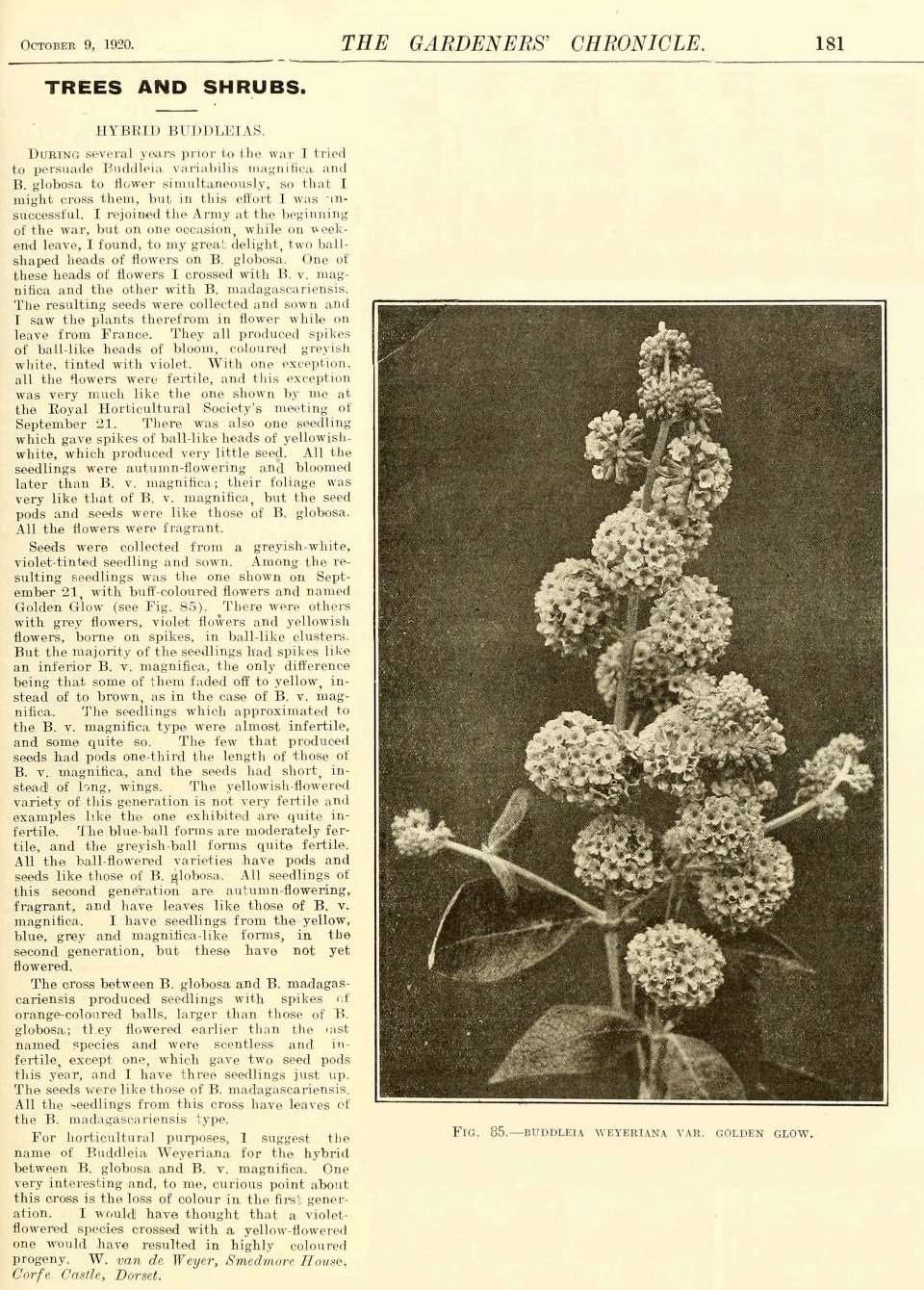
TREES AND SHRUBS:
HYBRID BUDDLEIAS.
Van de Weyer W. (1920)
The Gardeners' Chronicle. ser.3, 68: pp181.
During several years prior to the war I tried to persuade Buddleia variabilis magnifica and B. globosa to flower simultaneously, so that I might cross them, but in this effort I was unsuccessful. I rejoined the Army at the beginning of the war, but on one occasion, while on week-end leave, I found, to my great delight, two ball-shaped heads of flowers on B. globosa. One of these heads of flowers I crossed with B. v. magnifica and the other with B. madagascariensis. The resulting seeds were collected and sown and I saw the plants therefrom in flower while on leave from France. They all produced spikes of ball-like heads of bloom, coloured greyish white, tinted with violet. With one exception, all the flowers were fertile, and this exception was very much like the one shown by me at the Royal Horticultural Society's meeting of September 21. There was also one seedling which gave spikes of ball-like heads of yellowish-white, which produced very little seed. All the seedlings were autumn-flowering and bloomed later than B. v. magnifica ; their foliage was very like that of B. v. magnifica, but the seed pods and seeds were like those of B. globosa. All the flowers were fragrant.
Seeds were collected from a greyish-white, violet-tinted seedling and sown. Among the resulting seedlings was the one shown on September 21, with buff-coloured flowers and named Golden Glow (see Fig. 85). There were others with grey flowers, violet flowers and yellowish flowers, borne on spikes, in ball-like clusters. But the majority of the seedlings had spikes like an inferior B. v. magnifica, the only difference being that some of them faded off to yellow, instead of to brown, as in the case of B. v. magnifica. The seedlings which approximated to the B. v. magnifica type were almost, infertile, and some quite so. The few that produced seeds had pods one-third the length of those of B. v. magnifica, and the seeds had short, instead of long, wings. The yellowish-flowered variety of this generation is not very fertile and examples like the one exhibited are quite infertile. The blue-ball forms are moderately fertile, and the greyish-ball forms quite fertile. All the ball-flowered varieties have pods and seeds like those of B. globosa. All seedlings of this second generation are autumn-flowering, fragrant, and have leaves like those of B. v. magnifica. I have seedlings from the yellow, blue, grey and magnifica-like forms, in the second generation, but these have not yet flowered.
The cross between B. globosa and B. madagascariensis produced seedlings with spikes of orange-coloured balls, larger than those of B. globosa; they flowered earlier than the last named species and were scentless and infertile, except one, which gave two seed pods this year, and I have three seedlings just up. The seeds were like those of B. madagascariensis. All the seedlings from this cross have leaves of the B. madagascariensis type.
For horticultural purposes, I suggest the name of Buddleia Weyeriana for the hybrid between B. globosa and B. v. magnifica. One very interesting and, to me, curious point about this cross is the loss of colour in the first generation. I would have thought that a violet-flowered species crossed with a yellow-flowered one would have resulted in highly coloured progeny.
W. van de Weyer, Smedmore House, Corfe Castle, Dorset.

Email:
buddlejagarden@gmail.com
© The Buddleja Garden 2011-2024.